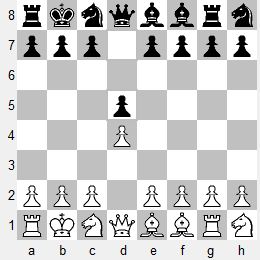The games were assigned SP826 RKNQBBRN, a lineup that can be seen in the diagram below. Both players opened with the natural 1.d4, occupying the center with a Pawn, making space for the Queen and Bishop, and providing a natural square for the Knight at d3. For similar reasons, both players continued 1...d5, reaching the diagram.

In my game with White, I gave the position some serious thought. A natural move is 2.Nd3, as previously prepared. Although castling O-O-O looks more likely, the King is not in any immediate danger and castling O-O will require only three additional moves: by a Pawn and the two Bishops. Since White can afford to wait to decide where to castle, the next step is to determine the development of the pieces from the c- through the f-files.
The more I looked at 2.Nd3, the less I liked it, because I couldn't find a good way to develop the other pieces. After e2-e3, the light squared Bishop will go to e2. Then the Queen must go to d2, but only after the dark squared Bishop develops further out on the a5-e1 diagonal. Neither of the squares b4 or c3 looked particularly attractive, and Black's ...e6 will anyway render Be1-b4 awkward. The real problem is that there are only two squares, d2 and e2, for three pieces, the Queen and Bishops.
One solution is to fianchetto the light squared Bishop to g2. This requires playing g2-g3, which has the obvious disadvantage of blocking the Knight on h1. Of course, that piece can go to f2, which requires pushing the f-Pawn. On top of adding two additional Pawn moves, the f- and g-Pawns, to the list of moves to be played, the f-Pawn is awkwardly placed both on f3, where it blocks the Bishop on g2, and on f4, where it leaves a raggedy stonewall formation d4-e3-f4-g3. There is much to be gained by harmony in a chess position, and this plan was as unharmonious as I could imagine. There had to be something better.
At that point I realized that the Knight on c1 isn't forced to develop to d3. It can also go to b3. With the Knight on b3, the squares d3, d2, and e2 are available for the Queen and two Bishops. The Knight on h1 will then go to g3. On top of all these positives, castling to either side remains an option, giving me plenty of time to observe the deployment of my opponent's pieces and act accordingly.
So as not to show my hand, I waited for my opponent's move as White. He played 2.Nd3, giving me the green light to play 2.e3 in my game as White and 2...e6 as Black. Note that, unlike the traditional start position, the single step of the e-Pawn does not interfere with a Bishop on the c-file. It's a good waiting move that doesn't reveal the plan behind it.
The first moves of my game with White were 1.d4 d5 2.e3 Nd6. Black insists on continuing with the development I had found wanting. Now I played 3.Bd3. This last move gave me a bonus that I hadn't noticed in my previous meditations: the undefended h-Pawn is attacked. Now after defending with 3...g6, Black has made the concession in logical development that I had so carefully avoided. After 4.Nb3 Bb5 5.Ng3 Bxd3 6.Qxd3 Bg7 7.Bc3 e6 8.f3 f5, the game steered off in a direction I hadn't anticipated, but my position was ready for it. I castled O-O, planning the central break e3-e4 before Black has completed his own development.
My game with Black went 1.d4 d5 2.Nd3 e6 3.Ng3 Ng6 4.e3 Nb6. White must have realized that the pieces were getting in each other's way, because he played 5.Bb4. After 5...Bxb4 6.Nxb4 Qe7 7.a3 Bd7, I was happy with my game and felt that I had already equalized.
I eventually won both games in the endgame. Given the many twists and turns in both games, it would be an exaggeration to say that I won because of the opening, but it certainly played a role. A winning game plan starts with the first moves.

1 comment:
On a forum thread about chess960-FRC several years ago, someone argued with me by saying (paraphrased) -
"Chess would not work with other start setups because the pieces need their traditional start squares in order for them to be able to fight for the center.
Therefore in most chess960 setups the opening phase would be unsatisfying because the players could not fight for the center.".
The clean logic of your opening moves when you were White argue elegantly and forcefully against that person's anti-chess960 claim. Nice job.
But...
Discard the 'Random' from Fischer Random Chess! ;-)
GeneM
Post a Comment